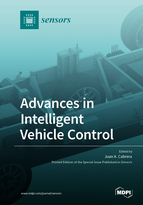Advances in Intelligent Vehicle Control
A special issue of Sensors (ISSN 1424-8220). This special issue belongs to the section "Intelligent Sensors".
Deadline for manuscript submissions: closed (20 September 2022) | Viewed by 42493
Special Issue Editor
Interests: vehicle dynamics; control of active safety systems; tire parameters estimation; artificial intelligence
Special Issues, Collections and Topics in MDPI journals
Special Issue Information
Dear Colleagues,
Advanced intelligent vehicle control systems have evolved in the last few decades thanks to the use of artificial intelligence-based techniques, the appearance of new sensors, and the development of technology necessary for their implementation. Therefore, a substantial improvement in safety, comfort, and performance of vehicles has been achieved. The appearance of new vehicles and technologies incorporated in them requires new control strategies that will keep on increasing handling, stability and energy efficiency.
This Special Issue will address innovative research in areas such as these:
- Active safety systems: development of intelligent control algorithms for anti-lock braking systems (ABS), traction control systems (TCS), electronic stability program (ESP) and related active safety features/devices integrated in new vehicles.
- Smart sensors: development of advanced strategies using future smart sensor technology and intelligent sensor fusion for the measurement and estimation of vehicle states, tire and road conditions, situation awareness assessment, environment mapping, fault diagnose and driving conditions.
- Intelligent and efficient driving: advanced vehicle control systems for assisted and autonomous driving and vehicle navigation through the incorporation of new sensors and measurement systems to develop new strategies to avoid critical driving situations and save energy.
The topics of interest include, but are not limited to the following:
- Active Safety Systems
- Vehicle Dynamics Control
- Autonomous Driving Systems
- Identification and Estimation
- Steering, Braking, Tires, Suspension
- Advanced Driver Assistance Systems
- Intelligent Sensors and Actuators
- Driver-Vehicle Systems
- Electric SmartVehicles
- Energy Management Strategies for Hybrid and Electric Vehicles
Prof. Dr. Juan A. Cabrera
Guest Editor
Manuscript Submission Information
Manuscripts should be submitted online at www.mdpi.com by registering and logging in to this website. Once you are registered, click here to go to the submission form. Manuscripts can be submitted until the deadline. All submissions that pass pre-check are peer-reviewed. Accepted papers will be published continuously in the journal (as soon as accepted) and will be listed together on the special issue website. Research articles, review articles as well as short communications are invited. For planned papers, a title and short abstract (about 100 words) can be sent to the Editorial Office for announcement on this website.
Submitted manuscripts should not have been published previously, nor be under consideration for publication elsewhere (except conference proceedings papers). All manuscripts are thoroughly refereed through a single-blind peer-review process. A guide for authors and other relevant information for submission of manuscripts is available on the Instructions for Authors page. Sensors is an international peer-reviewed open access semimonthly journal published by MDPI.
Please visit the Instructions for Authors page before submitting a manuscript. The Article Processing Charge (APC) for publication in this open access journal is 2600 CHF (Swiss Francs). Submitted papers should be well formatted and use good English. Authors may use MDPI's English editing service prior to publication or during author revisions.
Keywords
- Intelligent vehicle
- Intelligent transportation systems
- Vehicle safety
- Vehicle dynamic estimation
- Localization and mapping
- Sensor fusion
- Learning techniques/Deep learning.







